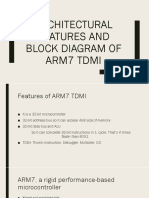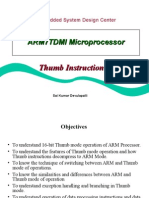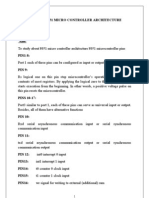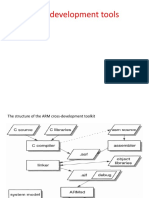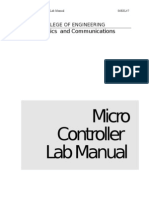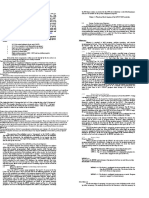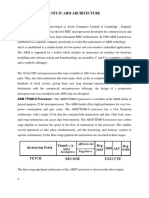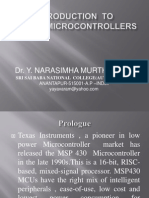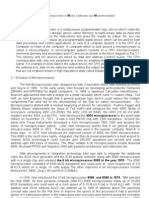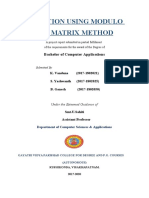Arm 7 Architecture
Arm 7 Architecture
Uploaded by
Narasimha Murthy YayavaramCopyright:
Available Formats
Arm 7 Architecture
Arm 7 Architecture
Uploaded by
Narasimha Murthy YayavaramOriginal Title
Copyright
Available Formats
Share this document
Did you find this document useful?
Is this content inappropriate?
Copyright:
Available Formats
Arm 7 Architecture
Arm 7 Architecture
Uploaded by
Narasimha Murthy YayavaramCopyright:
Available Formats
Dr.Y.Narasimha MurthyPh.D yayavaram@yahoo.
com
UNIT-II ARM 7 Microcontroller
INTRODUCTION: The ARM was originally developed at Acorn Computers Limited of Cambridge , England, between 1983 and 1985. It was the first RISC microprocessor developed for commercial use and has some significant differences from subsequent RISC architectures. In 1990 ARM Limited was established as a separate company specifically to widen the exploitation of ARM technology and it is established as a market-leader for low-power and cost-sensitive embedded
applications. The ARM is supported by a toolkit which includes an instruction set emulator for hardware modelling and software testing and benchmarking, an assembler, C and C++ compilers, a linker and a symbolic debugger.
The 16-bit CISC microprocessors that were available in 1983 were slower than standard memory parts. They also had instructions that took many clock cycles to complete (in some cases, many hundreds of clock cycles), giving them very long interrupt latencies.As a result of these frustrations with the commercial microprocessor offerings, the design of a proprietary microprocessor was considered and ARM chip was designed. ARM 7TDMI-S Processor : The ARM7TDMI-S processor is a member of the ARM family of general-purpose 32-bit microprocessors. The ARM family offers high performance for very low-power consumption and gate count. The ARM7TDMI-S processor has a Von Neumann architecture, with a single 32-bit data bus carrying both instructions and data. Only load, store, and swap instructions can access data from memory. The ARM7TDMI-S processor uses a three stage pipeline to increase the speed of the flow of instructions to the processor. This enables several operations to take place simultaneously, and the processing, and memory systems to operate continuously. In the three-stage pipeline the instructions are executed in three stages.
The three stage pipelined architecture of the ARM7 processor is shown in the above figure.
1
Dr.Y.Narasimha MurthyPh.D yayavaram@yahoo.com
ARM7TDMIS stands for T: THUMB ; D for on-chip Debug support, enabling the processor to halt in response to a debug request, M: enhanced Multiplier, yield a full 64-bit result, high performance I: Embedded ICE hardware (In Circuit emulator) S : Synthesizable FEATURES OF ARM PROCESSORS The ARM processors are based on RISC architectures and this architecture has provided small implementations, and very low power consumption. Implementation size, performance, and very low power consumption remain the key features in the development of the ARM devices. The typical RISC architectural features of ARM are : A large uniform register file A load/store architecture, where data-processing operations only operate on register contents, not directly on memory contents Simple addressing modes, with all load/store addresses being determined from register contents and instruction fields only uniform and fixed-length instruction fields, to
simplify instruction decode. Control over both the Arithmetic Logic Unit (ALU) and shifter in most data-processing instructions to maximize the use of an ALU and a shifter Auto-increment and auto-decrement addressing modes to optimize program loops Load and Store Multiple instructions to maximize data throughput Conditional execution of almost all instructions to maximize execution throughput.
There are three basic instruction sets for ARM. A 32- bit ARM instruction set A 16 bit Thumb instruction set and The 8-bit Java Byte code used in Jazelle state instruction set is a subset of the most commonly used32-bit ARM
The Thumb
instructions.Thumb instructions operate with the standard ARM register configurations ,enabling excellent interoperability between ARM and Thumb states.This Thumb state is nearly
2
Dr.Y.Narasimha MurthyPh.D yayavaram@yahoo.com
65% of the ARM code and can provide 160%of the performance of ARM code when working ona 16-bit memory system. This Thumb mode is used in embedded systems where memory resources are limited. The Jazelle mode is used in ARM9 processor to work with 8-bit Java code. ARCHITECTURE OF ARM PROCESSORS: The ARM 7 processor is based on Von Neman model with a single bus for both data and instructions..( The ARM9 uses Harvard model).Though this will decrease the performance of ARM, it is overcome by the pipe line concept. ARM uses the Advanced Microcontroller Bus Architecture (AMBA) bus architecture. This AMBA include two system buses: the AMBA High-Speed Bus (AHB) or the Advanced System Bus (ASB), and the Advanced Peripheral Bus (APB). The ARM processor consists of Arithmetic Logic Unit (32-bit) One Booth multiplier(32-bit) One Barrel shifter One Control unit Register file of 37 registers each of 32 bits.
In addition to this the ARM also consists of a Program status register of 32 bits, Some special registers like the instruction register, memory data read and write register and memory address register ,one Priority encoder which is used in the multiple load and store instruction to indicate which register in the register file to be loaded or stored and Multiplexers etc.
Dr.Y.Narasimha MurthyPh.D yayavaram@yahoo.com
ARM Registers : ARM has a total of 37 registers .In which - 31 are general-purpose registers of 32-bits, and six status registers .But all these registers are not seen at once. The processor state and operating mode decide which registers are available to the programmer. At any time, among the 31 general purpose registers only 16 registers are available to the user. The remaining 15 registers are used to speed up exception processing. there are two program status registers: CPSR and SPSR (the current and saved program status registers, respectively In ARM state the registers r0 to r13 are orthogonalany instruction that you can apply to r0 you can equally well apply to any of the other registers.
The main bank of 16 registers is used by all unprivileged code. These are the User mode registers. User mode is different from all other modes as it is unprivileged. In addition to this register bank ,there is also one 32-bit Current Program status Register(CPSR)
Dr.Y.Narasimha MurthyPh.D yayavaram@yahoo.com
In the 15 registers ,the r13 acts as a stack pointer register and r14 acts as a link register and r15 acts as a program counter register. Register r13 is the sp register ,and it is used to store the address of the stack top. R13 is used by the PUSH and POP ARMv6. Register 14 is the Link Register (LR). This register holds the address of the next instruction after a Branch and Link (BL or BLX) instruction, which is the instruction used to make a subroutine call. It is also used for return address information on entry to exception modes. At all other times, R14 can be used as a general-purpose register. Register 15 is the Program Counter (PC). It can be used in most instructions as a pointer to the instruction which is two instructions after the instruction being executed. The remaining 13 registers have no special hardware purpose. CPSR : The ARM core uses the CPSR register to monitor and control internal operations. The CPSR is a dedicated 32-bit register and resides in the register file. The CPSR is divided into four fields, each of 8 bits wide : flags, status, extension, and control. The extension and status fields are reserved for future use. The control field contains the processor mode, state, and instructions in T variants, and by the SRS and RFE instructions from
interrupt mask bits. The flags field contains the condition flags. The 32-bit CPSR register is shown below.
Dr.Y.Narasimha MurthyPh.D yayavaram@yahoo.com
Processor Modes: There are seven processor modes .Six privileged modes abort, fast interrupt request, interrupt request, supervisor, system, and undefined and one non-privileged mode called user mode. The processor enters abort mode when there is a failed attempt to access memory. Fast interrupt request and interrupt request modes correspond to the two interrupt levels available on the ARM processor. Supervisor mode is the mode that the processor is in after reset and is generally the mode that an operating system kernel operates in. System mode is a special version of user mode that allows full read-write access to the CPSR. Undefined mode is used when the processor encounters an instruction that is undefined or not supported by the implementation. User mode is used for programs and applications. Banked Registers : Out of the 32 registers , 20 registers are hidden from a program at different times. These registers are called banked registers and are identified by the shading in the diagram. They are available only when the processor is in a particular mode; for example, abort mode has banked registers r13_abt , r14_abt and spsr _abt. Banked registers of a particular
mode are denoted by an underline character post-fixed to the mode mnemonic or _mode. When the T bit is 1, then the processor is in Thumb state. To change states the core executes a specialized branch instruction and when T= 0 the processor is in ARM state and executes ARM instructions. There are two interrupt request levels available on the ARM processor core interrupt request (IRQ) and fast interrupt request (FIQ). V, C , Z , N are the Condition flags . V (oVerflow) : Set if the result causes a signed overflow C (Carry) Z (Zero) : Is set when the result causes an unsigned carry : This bit is set when the result after an arithmetic operation is zero, frequently used to indicate equality N (Negative) : This bit is set when the bit 31 of the result is a binary 1.
PIPE LINE : Pipeline is the mechanism used by the RISC processor to execute instructions at an increased speed. This pipeline speeds up execution by fetching the next instruction while other instructions are being decoded and executed. During the execution of an instruction ,the processor Fetches the instruction .It means loads an instruction from memory.And decodes the
6
Dr.Y.Narasimha MurthyPh.D yayavaram@yahoo.com
instruction i.e identifies the instruction to be executed and finally Executes the instruction and writes the result back to a register. The ARM7 processor has a three stage pipelining architecture namely Fetch , Decode and Execute.And the ARM 9 has five stage Pipe line architecture.The three stage pipelining is explained as below.
To explain the pipelining ,let us consider that there are three instructions Compare, Subtract and Add.The ARM7 processor fetches the first instruction CMP in the first cycle and during the second cycle it decodes the CMP instruction and at the same time it will fetch the SUB instruction. During the third cycle it executes the CMP instruction , while decoding the SUB instruction and also at the same time will fetch the third instruction ADD. This will improve the speed of operation. This leads to the concept of parallel processing .This pipeline shown in the following diagram. example is
Dr.Y.Narasimha MurthyPh.D yayavaram@yahoo.com
As the pipeline length increases, the amount of work done at each stage is reduced, which allows the processor to attain a higher operating frequency. This in turn increases the performance. One important feature of this pipeline is the execution of a branch instruction or branching by the direct modification of the PC causes the ARM core to flush its pipeline. Exceptions, Interrupts, and the Vector Table : Exceptions are generated by internal and external sources to cause the ARM processor to handle an event, such as an externally generated interrupt or an attempt to execute an Undefined instruction. The processor state just before handling the exception is normally preserved so that the original program can be resumed after the completion of the exception routine. More than one exception can arise at the same time.ARM exceptions may be considered in three groups 1. Exceptions generated as the direct effect of executing an instruction.Software interrupts, undefined instructions (including coprocessor instructions where the requested coprocessor is absent) and prefetch aborts (instructions that are invalid due to a memory fault occurring during fetch) come under this group. 2. Exceptions generated as a side-effect of an instruction.Data aborts (a memory fault during a load or store data access) are in this group. 3. Exceptions generated externally, unrelated to the instruction flow.Reset, IRQ and FIQ are in this group.
The ARM architecture supports seven types of exceptions. i.Reset ii.Undefined Instruction iii.Software Interrupt(SWI) iv. Pre-fetch abort(Instruction Fetch memory fault) v.Data abort (Data access memory fault) vi. IRQ(normal Interrupt) vii. FIQ (Fast Interrupt request). When an Exception occurs , the processor performs the following sequence of actions: It changes to the operating mode corresponding to the particular exception. It saves the address of the instruction following the exception entry instruction in r14 of the new mode.
8
Dr.Y.Narasimha MurthyPh.D yayavaram@yahoo.com
It saves the old value of the CPSR in the SPSR of the new mode. It disables IRQs by setting bit 7 of the CPSR and, if the exception is a fast interrupt, disables further fast interrupts by setting bit 6 of the CPSR. It forces the PC to begin executing at the relevant vector address
Excdption / Interrupt Reset Undefined Instruction Software Interrupt Pre-fetch Abort Data Abort Reserved Interrupt Request Fast Interrupt Request
Name RESET UNDEF SWI PABT DABT --IRQ FIQ
Address 0X00000000 0X00000004 0X00000008 0X0000000C 0X00000010 0X00000014 0X00000018 0X0000001C
High Address 0Xffff0000 0Xffff0004 0Xffff0008 0Xffff000c 0Xffff0010 0Xffff0014 0Xffff0018 0Xffff001c
The exception Vector table shown above gives the address of the subroutine program to be executed when the exception or interrupt occurs. Each vector table entry contains a form of branch instruction pointing to the start of a specific routine. Reset vector is the location of the first instruction executed by the processor when power is applied. This instruction branches to the initialization code. Undefined instruction vector is used when the processor cannot decode an instruction. Software interrupt vector is called when you execute a SWI instruction. The SWI instruction is frequently used as the mechanism to invoke an operating system routine. Pre-fetch abort vector occurs when the processor attempts to fetch an instruction from an address without the correct access permissions. The actual abort occurs in the decode stage. Data abort vector is similar to a prefetch abort but is raised when an instruction attempts to access data memory without the correct access permissions. Interrupt request vector is used by external hardware to interrupt the normal execution flow of the processor. It can only be raised if IRQs are not masked in the CPSR. ARM Processor Families There are various ARM processors available in the market for different application .These are grouped into different families based on the core .These families are based on the ARM7,
9
Dr.Y.Narasimha MurthyPh.D yayavaram@yahoo.com
ARM9, ARM10, and ARM11 cores. The designs. The ascending number Though ARM 8 indicates
numbers 7, 9, 10, and 11 indicate different core an increase in performance and sophistication.
was introduced during 1996, it is no more available in the market. The
following table gives a brief comparison of their performance and available resources.
The ARM7 core has a Von Neumannstyle architecture, where both data and instructions use the same bus. The core has a three-stage pipeline and executes the architecture ARMv4T instruction set. The ARM7TDMI was introduced in 1995 by ARM. It is currently a very popular core and is used in many 32-bit embedded processors.
The ARM9 family was released in 1997. It has five stage pipeline architecture .Hence , the ARM9 processor can run at higher clock frequencies than the ARM7 family. The extra stages improve the overall performance of the processor. The memory system has been redesigned to follow the Harvard architecture, with separate data and instruction .buses. The first processor in the ARM9 family was the ARM920T, which includes a separate D + I cache and an MMU. This processor can be used by operating systems requiring virtual memory support. ARM922T is a variation on the ARM920T but with half the D +I cache size. The latest core in the ARM9 product line is the ARM926EJ-S synthesizable processor core, announced in 2000. It is designed for use in small portable Java-enabled devices such as 3G phones and personal digital assistants (PDAs).
The ARM10 was released in 1999 . It extends the ARM9 pipeline to six stages. It also supports an optional vector floating-point (VFP) unit, which adds a seventh stage to the ARM10 pipeline. The VFP significantly increases floating-point performance and is compliant with the IEEE 754.1985 floating-point standard. The ARM1136J-S is the ARM11 processor released in the year 2003 and it is designed for high performance and power efficient applications. implementation to execute architecture ARM1136J-S was the first processor
ARMv6 instructions. It incorporates an eight-stage
pipeline with separate load store and arithmetic pipelines. A brief comparison of different ARM families is presented below.
10
Dr.Y.Narasimha MurthyPh.D yayavaram@yahoo.com
ARM Family ARM7 ARM9
Year of Architecture Release 1995 1997 Von Neumann Harvard Harvard Harvard
Pipeline Operational Multiplier MIPS Frequency 3 stage 5 stage 6 stage 8 stage 80 M.Hz 150M.Hz 260M.Hz 335M.Hz 8x32 8x32 16x32 16x32 0.97 1.1 1.3 1.2
ARM10 1999 ARM11 2003
ARM INSTRUCTION SET ARM instructions process data held in registers and only access memory with load and store instructions. ARM instructions commonly take two or three operands. For example ,the ADD instruction adds the two values stored in registers r1 and r2 (the source registers). It stores the result to register r3 (the destination register). ADD r3, r1, r2 ARM instructions are classified into data processing instructions, branch instructions, load-store instructions, software interrupt instruction, and program status register instructions.
Data Processing Instructions : The data processing instructions manipulate data within registers. They are move instructions, Arithmetic instructions, logical instructions, comparison instructions, and multiply instructions. Most data processing instructions can process one of their operands using the barrel shifter.
Data processing instructions are processed within the arithmetic logic unit (ALU). A unique and powerful feature of the ARM processor is the ability to shift the 32-bit binary pattern in one of the source registers left or right by a specific number of positions before it enters the ALU. This shift increases the power and flexibility of many data processing operations. There are data processing instructions that do not use the barrel shift, for example, the MUL (multiply), CLZ (count leading zeros), and QADD (signed saturated 32-bit add) instructions.
i.Move Instructions : Move instruction copies R into a destination register Rd, where R is a register or immediate value. This instruction is useful for setting initial values and transferring data between registers.
11
Dr.Y.Narasimha MurthyPh.D yayavaram@yahoo.com
Example1 :
PRE
r5 = 5 r7 = 8
MOV r7, r5 ; POST r5 = 5 r7 = 5
The MOV instruction takes the contents of register r5 and copies them into register r7. Example 2: MOVS r0, r1, LSL #1
MOVS instruction shifts register r1 left by one bit
Arithmetic Instructions : The arithmetic instructions implement addition and subtraction of 32-bit signed and unsigned values. the various addition and subtraction instructions are given in table below. SUB r0, r1, r2 ; This subtract instruction subtracts a value stored in register r2 from a value stored in register r1. The result is stored in register r0. RSB r0, r1, #0 ; This reverse subtract instruction (RSB) subtracts r1 from the constant value #0, writing. the result to r0. You can use this instruction to negate numbers.
SUBS r1, r1, #1 ; The SUBS instruction is useful for decrementing loop counters. In this example we subtract the immediate value one from the value one stored in register r1. The result value zero is written to register r1.
Logical Instructions : These Logical instructions perform bitwise logical operations on the two source registers.
12
Dr.Y.Narasimha MurthyPh.D yayavaram@yahoo.com
BIC r0, r1, r2 ; BIC, carries out a logical bit clear. register r2 contains a binary pattern where every binary 1 in r2 clears a corresponding bit location in register r1. This instruction is particularly useful when clearing status bits and is frequently used to change interrupt masks in the cpsr.
Comparison Instructions : The comparison instructions are used to compare or test a register with a 32-bit value. This instruction affects only CPSR register flags.
Branch Instructions: A branch instruction changes the normal flow of execution of a main program or is used to call a subroutine routine. This type of instruction allows programs to have subroutines, if-then-else structures, and loops. The change of execution flow forces the program counter pc to point to a new address.
Example 1:
forward ; ; ; ;
(unconditional branch to forward)
ADD r1, r2, #4 ADD r0, r6, #2 ADD r3, r7, #4 forward SUB r1, r2, #4 Similarly Backward branch :
13
Dr.Y.Narasimha MurthyPh.D yayavaram@yahoo.com backward : ADD SUB ADD B r1, r2, #4 ; r1, r2, #4 ; r4, r6, r7 ;
backward ; branch to the target backward.
The branch with link, or BL, instruction is similar to the B instruction but overwrites the link register lr with a return address. It performs a subroutine call. BL subroutine ; CMP r1, #5 ; branch to subroutine compare r1 with 5 if (r1==5) then r1 = 0 :
MOVEQ r1, #0 ; Subroutine MOV pc, lr ;
return by moving pc = lr
The Branch Exchange (BX) and Branch Exchange with Link (BLX) are the third type of branch instruction. The BX instruction uses an absolute address stored in register Rm. It is primarily used to branch to and from Thumb code. The T bit in the cpsr is updated by the least significant bit of the branch register. Similarly the BLX instruction updates the T bit of the cpsr with the least significant bit and additionally sets the link register with the return address.
The details of the branch instructions are given in the table above.
Load-Store Instructions : Load-store instructions transfer data between memory and processor
registers. There are three types of load-store instructions: Single-register transfer Multiple-register transfer, and
14
Dr.Y.Narasimha MurthyPh.D yayavaram@yahoo.com Swap. Single-Register Transfer : These instructions are used for moving a single data item in and out of a register. The data types supported are signed and unsigned words (32-bit), half-words (16-bit), and bytes. Ex1: STR r0, [r1] ; = STR r0, [r1, #0] ; store the contents of register r0 to the
memory address pointed to by register r1.
Ex2 : LDR r0, [r1] ; = LDR r0, [r1, #0] ; load register r0 with the contents of the memory address pointed to by register r1.
Multiple-Register Transfer : Load-store multiple instructions can transfer multiple registers between memory and the processor in a single instruction. The transfer occurs from a base address register Rn pointing into memory. Multiple-register transfer instructions are more efficient than single-register transfers for moving blocks of data around memory and saving and restoring context and stacks. Load-store multiple instructions can increase interrupt latency. ARM implementations do not usually interrupt instructions while they are executing. For example, on an ARM7 a load multiple instruction takes 2 + N.t cycles, where N is the number of registers to load and t is the number of cycles required for each sequential access to memory. If an interrupt has been raised, then it has no effect until the load-store multiple instruction is complete. Example 1: LDMIA r0!, {r1-r3} ; In this example, register r0 is the base register Rn and is followed by !, indicating that the register is updated after the instruction is executed. In this case the range is from register r1 to r3. Example 2 : LDMIB : load multiple and increment before Ex 3: Ex 4 : LDMIB r0!, {r1-r3} ; LDMDA r0!, {r1-r3}
15
Dr.Y.Narasimha MurthyPh.D yayavaram@yahoo.com
Stack Operations : The ARM architecture uses the load-store multiple instructions to carry out stack operations. The pop operation (removing data from a stack) uses a load multiple
instruction; similarly, the push operation (placing data onto the stack) uses a store multiple instruction. A stack is either ascending (A) or descending (D). Ascending stacks grow towards higher memory addresses; in contrast, descending stacks which grow towards lower memory addresses. When a full stack (F)is used , the stack pointer sp points to an address that is the last used or full location (i.e., sp points to the last item on the stack). In contrast, if an empty stack (E) is used , the sp points to an address that is the first unused or empty location (i.e., it points after the last item on the stack). Example1 : The STMFD instruction pushes registers onto the stack, updating the sp. STMFD sp! , {r1,r4}; Store Multiple Full Descending Stack PRE r1 = 0x00000002 r4 = 0x00000003 sp = 0x00080014
POST r1 = 0x00000002 r4 = 0x00000003 sp = 0x0008000c. The stack operation is shown by the following diagram.
Example2: The STMED instruction pushes the registers onto the stack but updates register sp to point to the next empty location as shown in the below diagram..
16
Dr.Y.Narasimha MurthyPh.D yayavaram@yahoo.com
PRE
r1 = 0x00000002 r4 = 0x00000003 sp = 0x00080010
STMED sp! , {r1,r4} ; Store Multiple Empty Descending Stack POST r1 = 0x00000002 r4 = 0x00000003 sp = 0x00080008 This operation is explained in the following figure.
Swap Instruction : The Swap instruction is a special case of a load-store instruction. It swaps (Similar to exchange) the contents of memory with the contents of a register. This instruction is an atomic operation it reads and writes a location in the same bus operation, preventing any other instruction from reading or writing to that location until it completes.Swap cannot be interrupted by any other instruction or any other bus access. So, the system holds the bus until the transaction is complete. Ex 1: SWP : Swap a word between memory and a register tmp = mem32[Rn] mem32[Rn] =Rm Rd = tmp
Ex2 :
SWPB
Swap a byte between memory and a register tmp = mem8[Rn] mem8[Rn] =Rm
17
Dr.Y.Narasimha MurthyPh.D yayavaram@yahoo.com
Rd = tmp.
Ex 3: SWP r0, r1, [r2] ; The swap instruction loads a word from memory into register r0 and overwrites the memory with register r1. Software Interrupt Instruction : A software interrupt instruction (SWI) is used to generate a software interrupt exception, which can be used to call operating system routines.When the
processor executes an SWI instruction, it sets the program counter pc to the offset 0x8 in the vector table. The instruction also forces the processor mode to SVC, which allows an operating system routine to be called in a privileged mode. Each SWI instruction has an associated SWI number, which is used to represent a particular function call or feature.
Ex:
0x00008000
SWI 0x123456 used by ARM toolkits as a debugging SWI. Typically
Here 0x123456, is the SWI number
the SWI instruction is executed in user mode. Program Status Register Instructions : There are two instructions available to directly control a program status register (PSR). The MRS instruction transfers the contents of either the CPSR or SPSR into a register.Similarly the MSR instruction transfers the contents of a register into the CPSR or SPSR .These instructions together are SPSR. MRS : copy program status register to a general-purpose register , Rd= PSR MSR : move a general-purpose register to a program status register, PSR[field]=Rm MSR : move an immediate value to a program status register, PSR[field]=immediate used to read and write the CPSR and
Ex :
MRS r1, CPSR BIC r1, r1, #0x80 ; 0b01000000 MSR CPSR_C, r1.
The MSR first copies the CPSR into register r1. The BIC instruction clears bit 7 of r1. Register r1 is then copied back into the CPSR, which enables IRQ interrupts. Here the code preserves all the other settings in the CPSR intact and only modifies the I bit in the control field.
18
Dr.Y.Narasimha MurthyPh.D yayavaram@yahoo.com
Loading Constants : In ARM instruction set there are no instructions to move the 32-bit constant into a register. Since ARM instructions are 32 bits in size, they obviously cannot specify a general 32-bit constant. To overcome this problem .two provided to move a 32-bit value into a register. LDR : load constant pseudo instruction Rd= 32-bit constant. ADR : load address pseudo instruction Rd=32-bit relative address. The first pseudo instruction writes a 32-bit constant to a register using whatever instructions are available. The second pseudo instruction writes a relative address into a register, which will be encoded using a PC -relative expression. Example 2: LDR r0, [pc, #constant_number-8-{PC}] constant _number DCD 0xff00ffff. pseudo instructions are
Here the LDR instruction loads a 32-bit constant 0xff00ffff into register r0. Example 3: The same constant can be loaded into the register r0 using the MVN instruction also. MVN r0, After execution #0x00ff0000 r0 = 0xff00ffff.
Introduction to Thumb instruction set : Thumb encodes a subset of the 32-bit ARM instructions into a 16-bit instruction set space. Since Thumb has higher performance than ARM on a processor with a 16-bit data bus, but lower performance than ARM on a 32-bit data bus, use Thumb for memory-constrained systems. Thumb has higher code densitythe space taken up in memory by an executable programthan ARM. For memory-constrained embedded systems, for example, mobile phones and PDAs, code density is very important. Cost pressures also limit memory size, width, and speed. Thumb execution is flagged by the T bit (bit [5] ) in the CPSR. A Thumb implementation of the same code takes up around 30% less memory than the equivalent ARM implementation. Even though the Thumb implementation uses more instructions ; the overall memory footprint is reduced. Code density was the main driving force for the Thumb instruction set. Because it was also designed as a compiler target, rather than for hand-written assembly code. Below example explains the difference between ARM and Thumb code
19
Dr.Y.Narasimha MurthyPh.D yayavaram@yahoo.com
From the above example it is clear that the Thumb code is more denser than the ARM code. Exceptions generated during Thumb execution switch to ARM execution before executing the exception handler . The state of the T bit is preserved in the SPSR, and the LR of the exception mode is set so that the normal return instruction performs correctly, regardless of whether the exception occurred during ARM or Thumb execution. In Thumb state, all the registers can not be accessed . Only the low registers r0 to r7 can be accessed. The higher registers r8 to r12 are only accessible with MOV, ADD, or CMP instructions. CMP and all the data processing instructions that operate on low registers update the condition flags in the CPSR The list of registers and their accessibility in Thumb mode are shown in the following table..
S.No 1 2 3 4 5 6 7
Registers r0 r7 r8 r12 r13SP r14 lr r15 PC CPSR SPSR Fully accessible
Access
Only accessible by MOV ,ADD &CMP Limited accessibility Limited accessibility Limited accessibility Only indirect access No access
20
Dr.Y.Narasimha MurthyPh.D yayavaram@yahoo.com
Form the above discussion, it is clear that there are no MSR and MRS equivalent Thumb instructions. To alter the CPSR or SPSR , one must switch into ARM state to use MSR and MRS. Similarly, there are no coprocessor instructions in Thumb state. You need to be in ARM state to access the coprocessor for configuring cache and memory management. ARM-Thumb interworking is the method of linking ARM and Thumb code together for both assembly and C/C++. It handles the transition between the two states. To call a Thumb routine from an ARM routine, the core has to change state. This is done with the T bit of CPSR . The BX and BLX branch instructions cause a switch between ARM and Thumb state while branching to a routine. The BX lr instruction returns from a routine, also with a state switch if necessary.
The data processing instructions manipulate data within registers. They include move instructions, arithmetic instructions, shifts, logical instructions, comparison instructions, and multiply instructions. The Thumb data processing instructions are a subset of the ARM data processing instructions.
Exs :
ADC : add two 32-bit values and carry Rd = Rd + Rm + C flag ADD : add two 32-bit values Rd = Rn + immediate Rd = Rd + immediate Rd = Rd + Rm
AND : logical bitwise AND of two 32-bit values Rd = Rd & Rm ASR : arithmetic shift right Rd = Rm_immediate, C flag= Rm[immediate 1] Rd = Rd_Rs, C flag = Rd[Rs - 1] BIC : logical bit clear (AND NOT) of two 32-bit Rd = Rd AND NOT(Rm)values CMN : compare negative two 32-bit values Rn + Rm sets flags CMP : compare two 32-bit integers Rnimmediate sets flags RnRm sets flags EOR : logical exclusive OR of two 32-bit values Rd = Rd EOR Rm LSL : logical shift left Rd = Rm_ immediate, C flag= Rm[32 immediate] Rd = Rd_Rs, C flag = Rd[32 Rs] LSR : logical shift right Rd = Rm_ immediate, C flag = Rd [immediate 1] Rd = Rd_ Rs, C flag = Rd[Rs 1] MOV : move a 32-bit value into a register Rd = immediate
21
Dr.Y.Narasimha MurthyPh.D yayavaram@yahoo.com
Rd = Rn Rd = Rm MUL : multiply two 32-bit values Rd = (Rm * Rd)[31:0] MVN : move the logical NOT of a 32-bit value into a register Rd = NOT(Rm) NEG : negate a 32-bit value Rd = 0 Rm ORR : logical bitwise OR of two 32-bit values Rd = Rd OR Rm ROR : rotate right a 32-bit value Rd = Rd RIGHT_ROTATE Rs, C flag= Rd[Rs1] SBC : subtract with carry a 32-bit value Rd = Rd Rm NOT(C flag) SUB : subtract two 32-bit values Rd = Rn immediate Rd = Rd immediate Rd = Rn Rm sp = sp (immediate_2) TST : test bits of a 32-bit value Rn AND Rm sets flags Note : Thumb deviates from the ARM style in that the barrel shift operations (ASR, LSL, LSR, and ROR) are separate instructions. Thankful to the following people for their invaluable information . References : 1. ARM System Developers Guide Designing and Optimizing System Software Andrew N. Sloss , Dominic Symes and Chris Wright. 2. ARM-System on-Chip Architecture Steve Furber.
3. ARM Architecture Reference Manual Copyright 1996-1998, 2000, 2004, 2005
ARM Limited.
22
You might also like
- ARM Notes For StudentsDocument24 pagesARM Notes For StudentsAkshit Sharma100% (1)
- Unit - 2 ARM Instruction Set-NotesDocument18 pagesUnit - 2 ARM Instruction Set-NotesRAMACHANDRA KHOTNo ratings yet
- ARM Unit 1 - Lecture NotesDocument19 pagesARM Unit 1 - Lecture NotesRangaraj A.GNo ratings yet
- Unit-4 Arm ArchitectureDocument71 pagesUnit-4 Arm ArchitectureChandu81870gmail.com KayithiNo ratings yet
- Modified Embedded Processors - TE (E&TC) PDFDocument4 pagesModified Embedded Processors - TE (E&TC) PDFbalaji_gawalwad9857No ratings yet
- Introduction To ARM Cortex-M ProcessorDocument19 pagesIntroduction To ARM Cortex-M ProcessorJay Patel100% (1)
- UNIT-V Realization of State MachinesDocument29 pagesUNIT-V Realization of State MachinesNarasimha Murthy Yayavaram100% (20)
- Power Supplies & RegulatorsDocument15 pagesPower Supplies & RegulatorsNarasimha Murthy YayavaramNo ratings yet
- UAE University-Configuration Templates Switches & RoutersDocument4 pagesUAE University-Configuration Templates Switches & RoutersSalman SadiqNo ratings yet
- Arm Program ModelDocument4 pagesArm Program ModelvlkumashankardeekshithNo ratings yet
- Architectural Features and Block Diagram of Arm7 TdmiDocument23 pagesArchitectural Features and Block Diagram of Arm7 TdmiMrunal Kshirsagar100% (1)
- Module 4 Topic 2 ARM Processor FundamentalsDocument64 pagesModule 4 Topic 2 ARM Processor FundamentalsDeepti ChandrasekharanNo ratings yet
- Arm ProcessorDocument18 pagesArm ProcessorashokNo ratings yet
- Thumb InstructionsDocument37 pagesThumb InstructionsSuhas ShirolNo ratings yet
- ARM - PPT 8Document74 pagesARM - PPT 8roysalways4u100% (1)
- (Lecture-07) The Thumb Instruction SetsDocument22 pages(Lecture-07) The Thumb Instruction SetsSuresh KumarNo ratings yet
- Pic Microcontroller - Class NotesDocument26 pagesPic Microcontroller - Class NotesNarasimha Murthy Yayavaram80% (25)
- ARM Exception HandlingDocument30 pagesARM Exception HandlingkarthikborkarNo ratings yet
- Lab Manual 8051Document40 pagesLab Manual 8051Gnanasambanthan Rajendran50% (2)
- Module-6 Thumb Instruction SetDocument54 pagesModule-6 Thumb Instruction Setsai Karthik100% (1)
- Cortex-M4 Part1Document65 pagesCortex-M4 Part1shalini100% (1)
- ARM Development ToolsDocument5 pagesARM Development ToolsAnshu Jindal50% (2)
- 3-Chapter - 10 - RTOS - Task CommunicationDocument9 pages3-Chapter - 10 - RTOS - Task CommunicationBhuvana GowdaNo ratings yet
- Arm MCQDocument12 pagesArm MCQAshok Kumar67% (6)
- DSP C16 - UNIT-6 (Ref-2)Document26 pagesDSP C16 - UNIT-6 (Ref-2)Vaishnavi. KoyaNo ratings yet
- Armv4T: Feature Arm7 Arm9E Arm11 Comparison of Arm7, Arm9 & Arm11 ArchitecturesDocument1 pageArmv4T: Feature Arm7 Arm9E Arm11 Comparison of Arm7, Arm9 & Arm11 Architecturesguddu100% (1)
- Department of Computer Science and EngineeringDocument25 pagesDepartment of Computer Science and EngineeringjesudosssNo ratings yet
- Comparative Study of 80286,80386,80486, Pentium ProcessorsDocument4 pagesComparative Study of 80286,80386,80486, Pentium Processorsr_als100% (1)
- 8086 and Memory Interfacing - FinalDocument28 pages8086 and Memory Interfacing - FinalAnushkaSinha100% (2)
- Unit 1 - ARM7Document67 pagesUnit 1 - ARM7Makrand KakatkarNo ratings yet
- Question Paper With Solution - The 8051 Microcontroller Based Embedded SystemsJUNE - JULY 2013 VTUDocument29 pagesQuestion Paper With Solution - The 8051 Microcontroller Based Embedded SystemsJUNE - JULY 2013 VTUmanishpatel_79100% (2)
- Unit 2 - ARM7 Based MicrocontrollerDocument106 pagesUnit 2 - ARM7 Based MicrocontrollerKunal Khandelwal100% (1)
- Advanced Arm Processors: Ch. S. V. Maruthi Rao Associate Professor Department of ECE, S. I. E. TDocument27 pagesAdvanced Arm Processors: Ch. S. V. Maruthi Rao Associate Professor Department of ECE, S. I. E. TMaruthi RaoNo ratings yet
- UNIT-5: Task CommunicationDocument30 pagesUNIT-5: Task CommunicationFarheenNo ratings yet
- MCQ Bank For ARM in FormatDocument8 pagesMCQ Bank For ARM in FormatSubrat Kumar Pradhan75% (4)
- Unit 1 - ARM7, ARM9, ARM11 ProcessorsDocument88 pagesUnit 1 - ARM7, ARM9, ARM11 ProcessorsKunal Khandelwal50% (2)
- Classification of Embedded SystemDocument2 pagesClassification of Embedded Systemrajesh0% (1)
- Features of Lpc2148.Document9 pagesFeatures of Lpc2148.Sampathhhhh Sai Tadepalli86% (7)
- AVR Microcontroller Question BankDocument2 pagesAVR Microcontroller Question BankmadhurithkNo ratings yet
- 8086 - Interfacing Analog To Digital Converters (ADC)Document22 pages8086 - Interfacing Analog To Digital Converters (ADC)PARIJAAT B MITRANo ratings yet
- MODULE 4: 8051 Serial Port Programming in Assembly and C: Microcontroller Notes:18EE52Document51 pagesMODULE 4: 8051 Serial Port Programming in Assembly and C: Microcontroller Notes:18EE52SuprithaNo ratings yet
- Serial Communication Bus-Interface (Unit3)Document44 pagesSerial Communication Bus-Interface (Unit3)Surekha PittaNo ratings yet
- How To Choose An RTOSDocument6 pagesHow To Choose An RTOSsyedashmad67% (3)
- Hardwired Control UnitDocument2 pagesHardwired Control Unitcafeinternet2004100% (1)
- 02 ARM Processor FundamentalsDocument65 pages02 ARM Processor Fundamentalsbengaltiger100% (2)
- PIC18F458PPTDocument58 pagesPIC18F458PPTdgkanade72No ratings yet
- Interrupts in DSPDocument2 pagesInterrupts in DSPGouse ModeenNo ratings yet
- 8096 Microcontrollers NotesDocument9 pages8096 Microcontrollers NotesNarasimha Murthy YayavaramNo ratings yet
- 8051 Manual FinDocument39 pages8051 Manual Finnagaraj100% (2)
- ArmDocument44 pagesArmSiva SankaranNo ratings yet
- 8051 Microcontroller (2 Marks - Question Bank)Document13 pages8051 Microcontroller (2 Marks - Question Bank)Dr. N.Shanmugasundaram97% (34)
- Chapter 2introduction To The C2xx DSP Core and Code GenerationDocument4 pagesChapter 2introduction To The C2xx DSP Core and Code Generationdivya624No ratings yet
- MODULE 3: 8051 Programming in C: Microcontroller Notes:18EE52Document62 pagesMODULE 3: 8051 Programming in C: Microcontroller Notes:18EE52Supritha100% (1)
- DAC ADC Interfacing With 8051Document37 pagesDAC ADC Interfacing With 8051Gowri100% (2)
- 7 Alternative Forms of Pull-UpDocument15 pages7 Alternative Forms of Pull-UpRajesh Pyla67% (3)
- Low Power ROMDocument5 pagesLow Power ROMParul JohariNo ratings yet
- Embedded SystemDocument20 pagesEmbedded Systemvenkat7186100% (1)
- Unit - I - ARM Processor - Dr. M. R. ArunDocument3 pagesUnit - I - ARM Processor - Dr. M. R. ArunArun John M R100% (2)
- Unit IV MPMCDocument22 pagesUnit IV MPMCDeepika SanalaNo ratings yet
- Arm NotesDocument22 pagesArm NotesShreya SatheeshNo ratings yet
- Arm 7 ArchitectureDocument22 pagesArm 7 Architecturejinto0007No ratings yet
- Arm 7 ArchitectureDocument22 pagesArm 7 Architecturestella nNo ratings yet
- ARM 4 Part2Document9 pagesARM 4 Part2SUGYAN ANAND MAHARANANo ratings yet
- UNIT III-Digital System DesignDocument13 pagesUNIT III-Digital System DesignNarasimha Murthy YayavaramNo ratings yet
- UNIT-I Digital System DesignDocument28 pagesUNIT-I Digital System DesignNarasimha Murthy YayavaramNo ratings yet
- Unit Ii: CPLD & Fpga Architecture & ApplicationsDocument20 pagesUnit Ii: CPLD & Fpga Architecture & ApplicationsNarasimha Murthy Yayavaram100% (1)
- Unit Iii: CPLD & Fpga Architecture & ApplicationsDocument30 pagesUnit Iii: CPLD & Fpga Architecture & ApplicationsNarasimha Murthy Yayavaram100% (7)
- Sensors Interfacing TechniquesDocument16 pagesSensors Interfacing TechniquesRaja VenkateshNo ratings yet
- MOS and BiCMOS Circuit Design ProcessDocument17 pagesMOS and BiCMOS Circuit Design ProcessNarasimha Murthy YayavaramNo ratings yet
- Basics of Peripheral Devices and WorkingDocument33 pagesBasics of Peripheral Devices and WorkingNarasimha Murthy Yayavaram100% (1)
- Control Systems - NotesDocument61 pagesControl Systems - NotesNarasimha Murthy YayavaramNo ratings yet
- Introduction To MSP430 MicrocontrollersDocument70 pagesIntroduction To MSP430 MicrocontrollersNarasimha Murthy Yayavaram100% (1)
- Introduction To VHDL ProgrammingDocument68 pagesIntroduction To VHDL ProgrammingNarasimha Murthy YayavaramNo ratings yet
- Pic Microcontroller - Class NotesDocument26 pagesPic Microcontroller - Class NotesNarasimha Murthy Yayavaram80% (25)
- Introduction To MasmDocument13 pagesIntroduction To MasmNarasimha Murthy Yayavaram100% (3)
- 8096 MicrocontrollerDocument51 pages8096 MicrocontrollerNarasimha Murthy Yayavaram67% (3)
- Embedded Systems-UnitIDocument33 pagesEmbedded Systems-UnitINarasimha Murthy YayavaramNo ratings yet
- Introduction To 68HC11 MICROCONTROLLERDocument72 pagesIntroduction To 68HC11 MICROCONTROLLERNarasimha Murthy Yayavaram100% (3)
- 8096 Microcontrollers NotesDocument9 pages8096 Microcontrollers NotesNarasimha Murthy YayavaramNo ratings yet
- Unit-III Telugu AckDocument46 pagesUnit-III Telugu AckNarasimha Murthy YayavaramNo ratings yet
- KMPH PDFDocument8 pagesKMPH PDFKhairul Hafizh FirdausNo ratings yet
- YashwanthDocument98 pagesYashwanthChaitu KumariNo ratings yet
- DSLS Installation and Configuration Guide 23xDocument190 pagesDSLS Installation and Configuration Guide 23xIgor EduardoNo ratings yet
- Project Report On Industrial Automation by Jatin Kundara, EI & CE Branch From Govt - Engg College, AjmerDocument41 pagesProject Report On Industrial Automation by Jatin Kundara, EI & CE Branch From Govt - Engg College, AjmerjatinkundaraNo ratings yet
- Sharepoint 1Document16 pagesSharepoint 1florinasuNo ratings yet
- EKramer BADocument11 pagesEKramer BAM BNo ratings yet
- ICS Session 02. LECTURE PPT - Why Cyber Security Is So Important v1Document16 pagesICS Session 02. LECTURE PPT - Why Cyber Security Is So Important v1dusexNo ratings yet
- Mks ConfigDocument5 pagesMks ConfigAFRV1987No ratings yet
- Fire Detection System Using NodemcuDocument13 pagesFire Detection System Using Nodemcupriya mNo ratings yet
- AZ-500 Exam - Free Actual Q&as, Page 3 - ExamTopicsDocument5 pagesAZ-500 Exam - Free Actual Q&as, Page 3 - ExamTopicscotit93331No ratings yet
- Service Menu: Operación de SistemasDocument8 pagesService Menu: Operación de Sistemasjuan castaedaNo ratings yet
- How To Enable Diagnostics On The Help Menu and Gather A Forms Trace (Doc ID 778955.1)Document2 pagesHow To Enable Diagnostics On The Help Menu and Gather A Forms Trace (Doc ID 778955.1)harishNo ratings yet
- Java Exam Paper 619402Document1 pageJava Exam Paper 619402Deep ValaNo ratings yet
- Ameyo Questionnaire ShortDocument9 pagesAmeyo Questionnaire Shortmohammed nabilNo ratings yet
- MLT UT1 Ques-2021Document2 pagesMLT UT1 Ques-2021Ãbhilâśh RêddÿNo ratings yet
- Chapter One (Net Admin 2021)Document55 pagesChapter One (Net Admin 2021)Mirko MekonenNo ratings yet
- DCS Vivaldi DAC v2 0 DatasheetDocument2 pagesDCS Vivaldi DAC v2 0 DatasheetHéritier NealNo ratings yet
- Building Transformer-Based Natural Language Processing ApplicationsDocument3 pagesBuilding Transformer-Based Natural Language Processing ApplicationsGraceSevillanoNo ratings yet
- Datasheet Server VMS Dell Poweredge R760xd2Document3 pagesDatasheet Server VMS Dell Poweredge R760xd2windu.prasetya24No ratings yet
- Dspace Cris Installation On CentosDocument10 pagesDspace Cris Installation On CentosJaipal SinghNo ratings yet
- Boq Fibre 1Document2 pagesBoq Fibre 1wasswaNo ratings yet
- Cloud Identity Engine Release NotesDocument30 pagesCloud Identity Engine Release Notesrazzaque003No ratings yet
- Stick LoggerDocument2 pagesStick LoggerjoseNo ratings yet
- Chapter 5 - Dataflow ModelingDocument42 pagesChapter 5 - Dataflow ModelingPhạm Gia LongNo ratings yet
- F7D7602V2 8820ed01325uk RevC00 NetCamDocument46 pagesF7D7602V2 8820ed01325uk RevC00 NetCamEmeric SzelesNo ratings yet
- Incorta Pricing Deck For Partners July 27 2022Document10 pagesIncorta Pricing Deck For Partners July 27 2022Mridu TiwariNo ratings yet
- Datasheet of VWC2 HPro - 2021 V1.01Document2 pagesDatasheet of VWC2 HPro - 2021 V1.01Ordinary PeopleNo ratings yet
- Crit C DevelopmentDocument4 pagesCrit C DevelopmentAlex HigginsNo ratings yet
- Microsoft Power PlatformDocument23 pagesMicrosoft Power PlatformcallmeasbalannNo ratings yet










